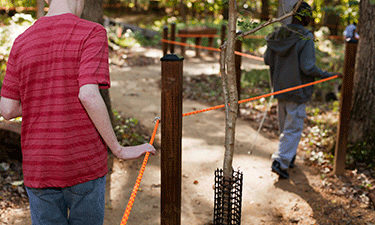 As program director for the Maryland Department of Natural Resource’s Conservation Job Corps, Fred Banks manages a lot of youth volunteers and has been privy to a number of off-the-wall ideas. But last fall, when some of his teen volunteers with disabilities suggested they develop a nature trail for others with similar impairments, Banks took notice.
As program director for the Maryland Department of Natural Resource’s Conservation Job Corps, Fred Banks manages a lot of youth volunteers and has been privy to a number of off-the-wall ideas. But last fall, when some of his teen volunteers with disabilities suggested they develop a nature trail for others with similar impairments, Banks took notice.
“They asked us, ‘Have you ever thought about doing a trail for everybody?’” Banks recalls. “We ran it past the park managers [at Patapsco Valley State Park], and they thought it was a good idea.”
Just west of Baltimore, Patapsco Valley State Park is centrally located in Maryland, making it a convenient spot for such a project. The park also features a number of elements that made it attractive for a sensory trail, including climbable rocks, gently sloping topography and audible wildlife. “We have probably one of the foremost experts on trails who works at the park, Ranger Amy Lutsko,” Banks says. “She gave some insight on what type of topography we’d want to look for if there were existing unmaintained trails that we could take over, which is what we did, or if we should just start from scratch. We went from one end of the Patapsco to the other to find a perfect spot, and found one right outside the nature center.”
A grant provided by the National Park Service and the Scrooby Foundation funded the initial phase of development, and Banks and his corps of volunteers quickly got to work. To develop plans for the trail, Project Coordinator Chass Seymour enlisted the unique perspectives of students at the nearby Maryland School for the Blind. “We got a lot of ideas from the kids at the Maryland School for the Blind,” Banks says. “They came out on several occasions after school to walk the trail and tell us what they like and didn’t like. That information was invaluable — there was no way we could have done it without them.”
Their input led to a number of modifications to the original plans. For example, the trail crews had originally intended to take out a number of rocks along the trail, thinking they would cause obstructions for blind hikers, but it turned out that the kids loved climbing on the rocks and using them as places to sit, so they were left in place.
“We had no idea what to look for,” Banks freely admits. “The things that we thought would be obstacles when they got on the trail, they were just like, ‘Nope, we love it!’”
In addition to factoring in the thoughts and opinions from the local visually impaired population, Seymour also enlisted a group of community members in wheelchairs to test out the surfacing and grade of the path. “The grade goes downhill, then there’s a dip when they come back up,” Banks says. “We looked at people who use wheelchairs and wondered, would the incline be too much for them to get up?” Seymour and Banks encouraged the volunteers working on the project to experience the trail as their intended audience would, using blindfolds or wheelchairs to help them make the connection. “We’re rookies, so navigating that hill in wheelchairs was a little strange for us, but people who use normally wheelchairs blew right through that.”
In addition to navigability and safety concerns, the project team strove to include elements that would enhance users’ sensory experience along the trail. To stimulate the sense of smell, fragrant plants and herbs were included in the plans, as well as foliage unique to the touch, such as lamb’s ear. A sound garden with drums and wind chimes was also mapped out to provide an auditory component, plus a number of bluebird boxes along the trail to attract colorful wildlife that would delight visitors with their songs. A guide rope offers a continuous navigation tool for the 0.1-mile trail, and bells on the guideposts mark special elements visitors wouldn’t want to miss. Finally, signage in Braille gives visually impaired walkers a chance to learn more about their surroundings.
The volunteer corps completed most of the construction this July, although finishing touches continued into the early fall. The trail opened to the public on October 16, and the team behind it is already gathering input from users for additional developments and tweaks to put into place next summer.
“There’s so much more than sight that we take advantage of,” Banks says. “These kids pick up on stuff I miss every single day.”
Danielle Taylor is the Executive Editor of Parks & Recreation Magazine.

